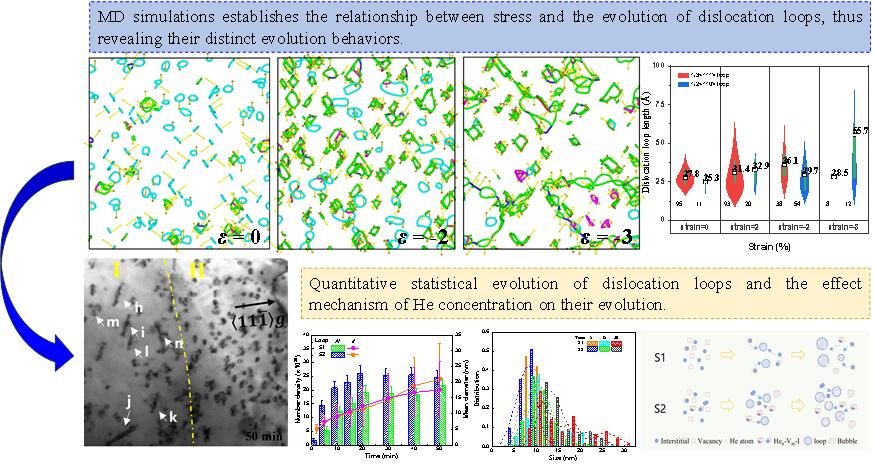Significant progress in the fundamental research on irradiation effects in high-temperature nickel-based alloy
Recently, the alloy irradiation research team of Shanghai Institute of Applied Physics, collaboration with Professor Huiqiu Deng’s team from Hunan University, has made significant progress in the fundamental research on irradiation effects in nickel-based alloys. Through a combination of experimental studies and molecular dynamics simulations, they thoroughly elucidated the effect mechanism of stress and helium concentration on dislocation loops evolution in GH3535 alloy during dual-beam irradiation. These findings have been published in Journal of Materials Science & Technology (Category 1 in Materials Science, IF 11.2) under the title “The effect of stress state and He concentration on the dislocation loop evolution in Ni superalloy irradiated by Ni+ & He+ dual-beam ions: in-situ TEM observation and MD simulations”. The co-first authors of the paper are Dr. Zhenbo Zhu and Dr. Rongyang Qiu (Hunan University), the corresponding authors are Prof. Hefei Huang and Prof. Huiqiu Deng of Hunan University.
Neutron irradiation in reactor is one of the main factors affecting the long-term stability of structure and properties of metal materials. Due to the limitation of neutron irradiations and experimental characterization techniques, the synergistic evolution mechanism of irradiation induced helium bubbles and dislocation loops is still unclear. To better simulate the neutron irradiation environment in molten salt reactors and to comprehensively study the evolution mechanism of irradiation damage in nickel-based alloys, the alloy irradiation research team firstly used an H2+ & He+ dual-beam irradiation with in-situ characterization to observe the defect evolution process in real time. This research discovered and revealed the mechanisms involving the effect of pre-excited dislocation loops on subsequent irradiation defect evolution, the loop-punching mechanism, and the evolution mechanism of rhombus-shape loop [Journal of Materials Science & Technology 138 (2023) 36, ESI Highly Cited Paper]. Based on this research, the alloy irradiation research team conducted further experiments using Ni+ & He+ dual-beam irradiation and in-situ characterization. They revealed that higher helium concentrations promote the nucleation of dislocation loops and facilitate the unfaulting behaviour of Frank loops by increasing the local stacking fault energy. Additionally, two distinct evolutions of dislocation loops, driven by residual stresses, were observed within the monitored grains. Molecular dynamics simulations established a clear relationship between stress state and magnitude and the evolution of dislocation loops during ion beam irradiation. The stress state was found to influence the preferential orientation of the loops; compressive stress lowers the formation energy of perfect dislocation loops, promoting their nucleation, and leading to a decrease in the density but an increase in the size of dislocation loops.
This work was financially supported by the National Natural Science Foundation of China and the Young Potential Program of Shanghai Institute of Applied Physics, Chinese Academy of Sciences.
Link: https://doi.org/10.1016/j.jmst.2024.06.015Figure. Molecular dynamics simulations establish a clear relationship between stress state and magnitude and the evolution of dislocation loops during ion beam irradiation, the effect mechanism of helium concentration on dislocation loop evolution.







